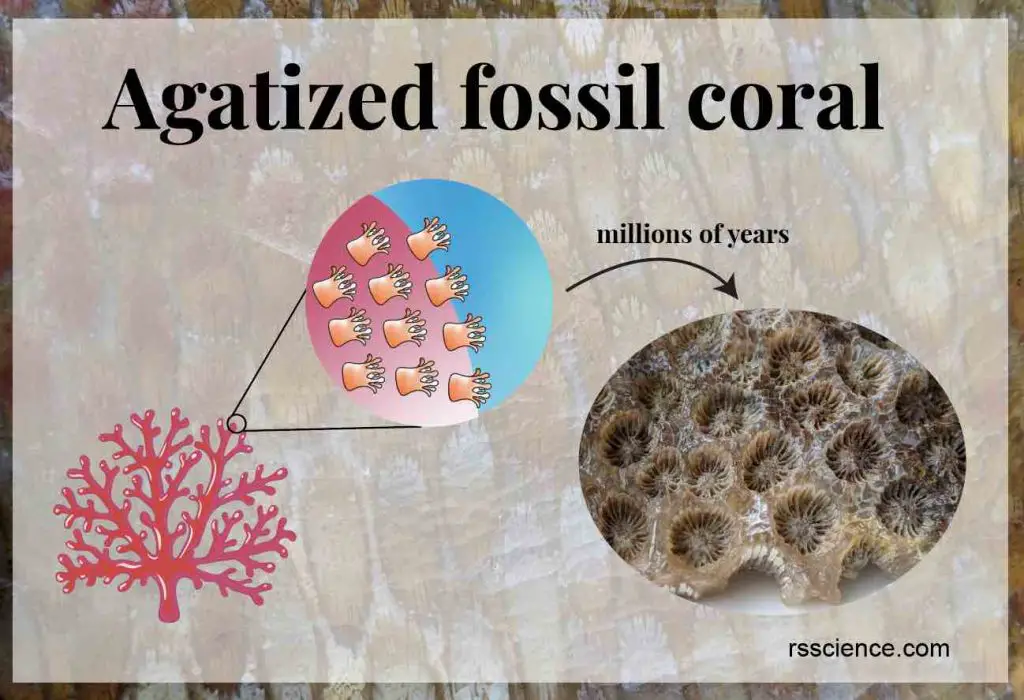This article covers
What are corals?
Corals are marine animals that resemble the miniature of sea anemones. In terms of their taxonomy, corals belong to the phylum Cnidaria (nid-AIR-ee-a), which includes jellyfish, sea anemones, and hydra. They all have a common feature, using stinging cells on their tentacles to protect themselves or hunt for food. Cnidaria are predominantly marine species, but a smaller number of species (including hydras) are found in rivers and freshwater lakes.
The soft, jelly-like body of an individual cnidarian animal is called a polyp. Some of them live as solitary individuals and some of them form colonies.
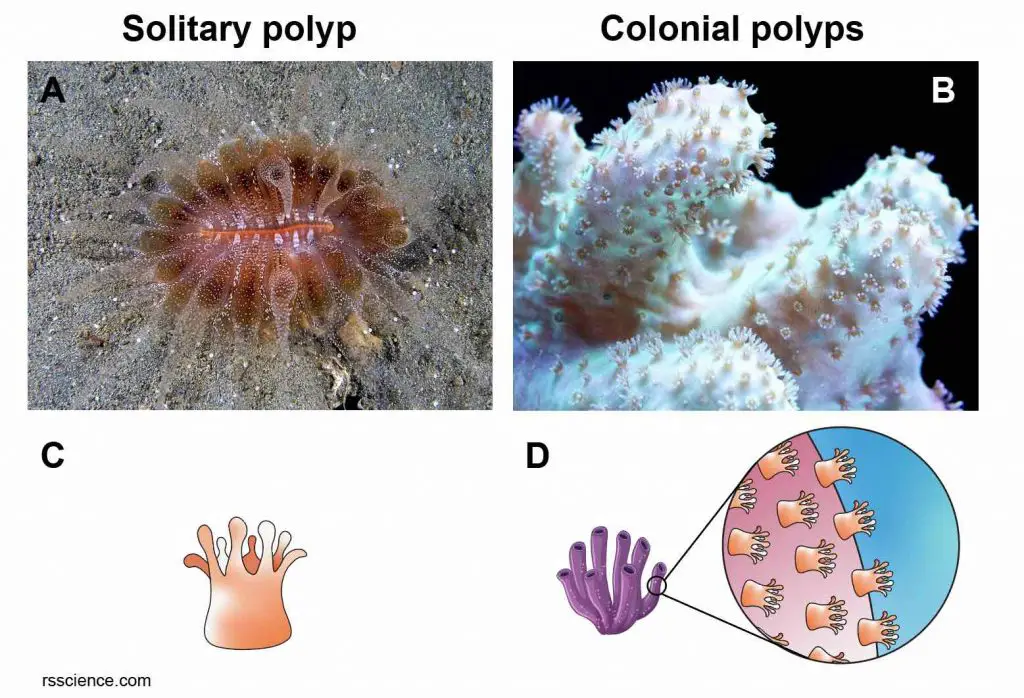
[In this image] Illustration of the coral morphology.
(A) Polyp of the solitary coral Flabellum sp, (B) A colony comprised of many individual polyps (finger leather coral), (C) Illustration of single solitary polyp, (D) Illustration of polyps forming a colony.
Photo credit: (A) wiki commons; (B) Tidal gardens
Anatomy of corals
Coral polyps are soft-bodied with multiple arms or tentacles. Each tentacle is clothed with many stinging cells. Upon contact with prey, the contents of the stinging cells are explosively discharged, firing stings that can paralyze small animals.
Many corals form a symbiotic relationship with the zooxanthellae, a yellowish-brown dinoflagellate, which live in the cytoplasm of the polyp cells. Zooxanthellae can produce energy and nutrients via photosynthesis and supply energy to corals. In return, corals provide shelter places for zooxanthellae. The yellowish-brown zooxanthellae also give coral colors.
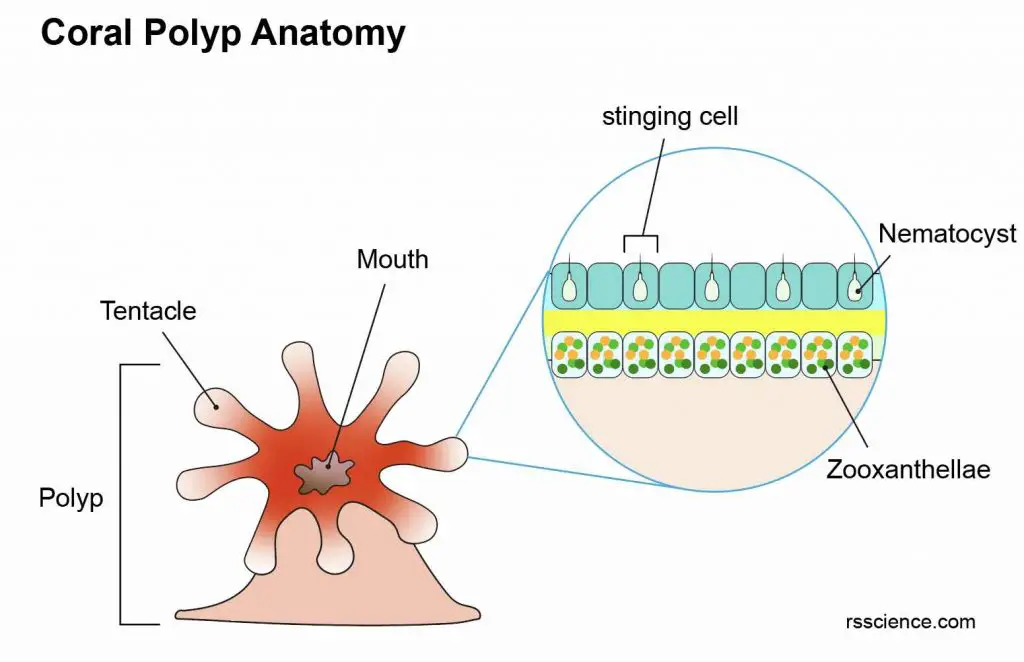
[In this image] Coral polyps anatomy.
Individual coral polyps exhibit one mouth in the center and multiple tentacles. Each tentacle is covered with highly specialized stinging cells. Stinging cells contain specialized structures called nematocysts, which look like miniature light bulbs with a coiled thread inside. Zooxanthellae are dinoflagellates, a group of protists that live within the tissue of the polyps.
Coral polyps secrete a rock-like skeleton (mainly calcium carbonate, CaCO3) around them. As the polyps grow, they build more calcium carbonate under the coenosarc, a living tissue overlying the stony skeleton of the coral. When the polyps die, their soft tissue decay, but the hard skeleton is left behind. The hard skeleton of ancient coral gets preserved as a fossil.
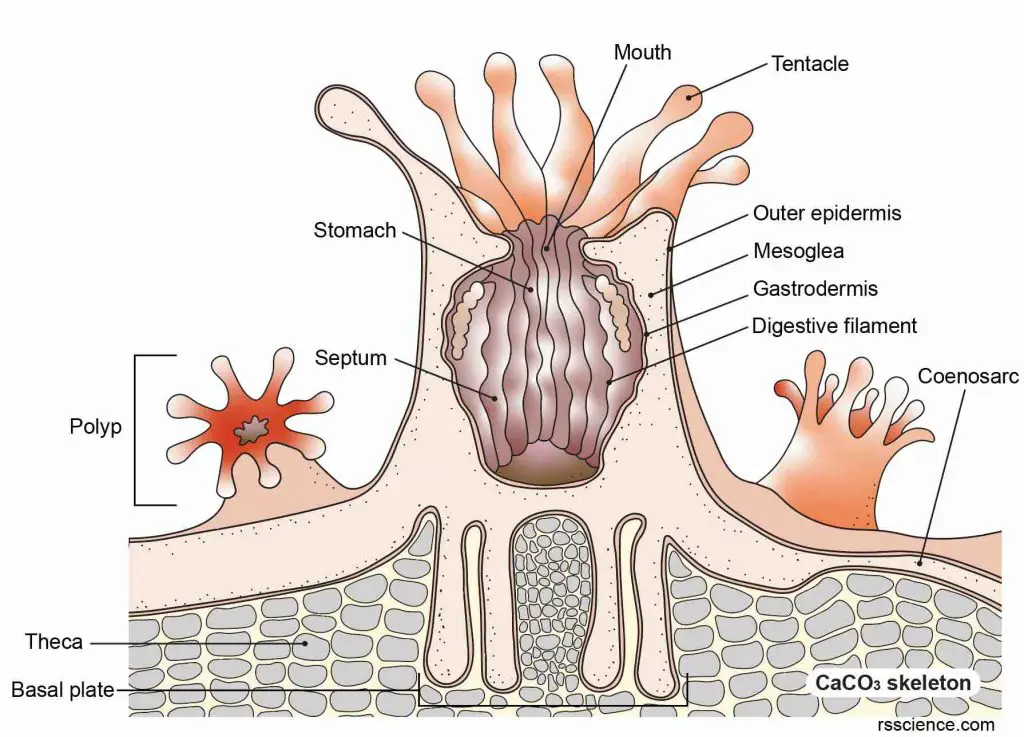
[In this image] The structure of coral polyps colony.
As polyps grow, they deposit rock-like calcium carbonate skeleton around them. Coenosarc is the living tissue overlying the stony skeleton of the coral. A septum (plural septa) is a radial skeleton inside polyps.
What is agatized fossil coral?
Agatized fossil coral is a natural gemstone with a beautiful flower pattern that resembles the appearance of individual coral polyps. See the images below for examples.
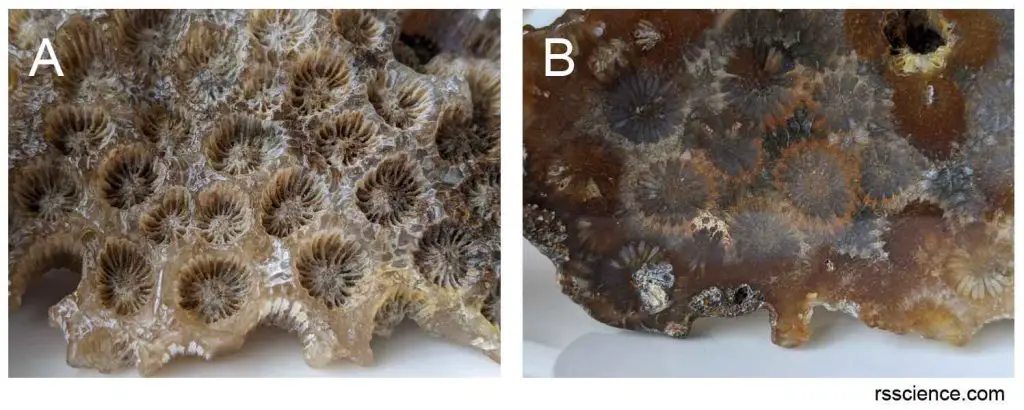
[In this image] The agatized fossil coral raw stone.
Two images are from the same agatized fossil coral raw stone but from two different sides. The coral skeleton is what is preserved as a fossil (A). After being polished, the skeleton of each polyp looks like flowers (B).
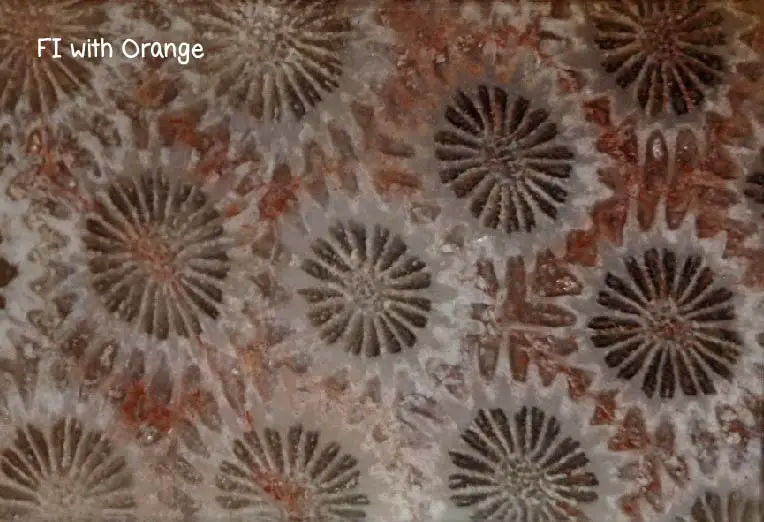
[In these images] Agatized fossil corals with a beautiful flower pattern.
Photo credit: Fi with Orange
How does agatized fossil coral form?
Agatized fossil corals were created when prehistoric reef-building corals were slowly replaced with agate (ie. silicon dioxide, SiO2). During that time, the silica-rich deposits of the water gradually replaced the limy skeleton with microcrystalline quartz. The entire process can take over 20 million years.
During the process, different minerals can be incorporated into agatized corals; therefore, resulting in a variety of colors from chalky white, brown, yellow, pink to crimson red. If the agatized fossil coral contains more iron (Fe), it will appear red. If containing magnesium (Mg), it will appear white. The combination of iron and magnesium can make it soft pink. The mineral copper (Cu) makes it green, while the mineral manganese (Mn) makes it black.
The agatized fossil coral is also ” Florida State Rock” due to its abundance of fossil corals. Florida and Georgia also produce some agatized fossil coral, but those obtained from the regions of Indonesia are most beautiful and unique.
What does agatized fossil coral look like?
Colors
The agatized fossil corals have a variety of colors. White, light pink, orange, yellow, green, gray, red, purple, gray-blue, and black.
Patterns
The agatized fossil corals possess the properties of the coral along with the agate. They exhibit skeletal-like coral patterns, like flowers, lemon slices, and laces. Sometimes, you can see tiny crystals deposit inside it, reflecting the property of agate.
Interesting in getting agatized fossil corals? You can buy them here.
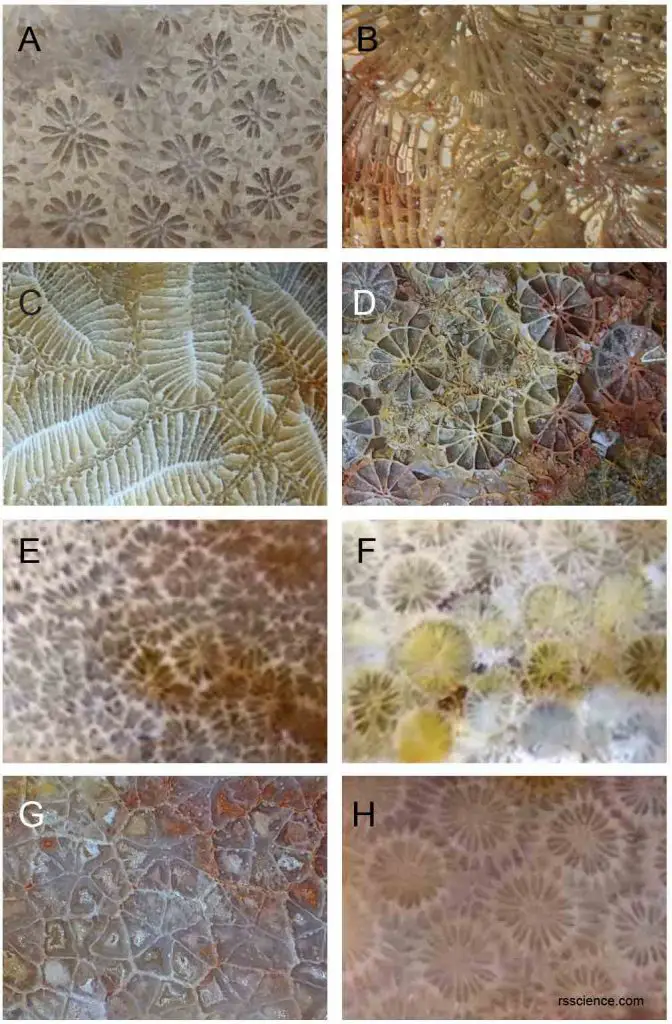
[In this image] Examples of patterns of agatized fossil coral.
(A) Flowers-like daisies pattern; (B) Bird-tail pattern; (C) Worm-like pattern; (D) Lace-like pattern; (E) Maple leaves-like pattern; (F) Lemon slice-like pattern; (G) Mosaic pattern; (H) Chrysanthemum pattern. More patterns can be found here.
Translucence
The raw agatized fossil coral is dull. After being polished, it becomes waxy and luster.
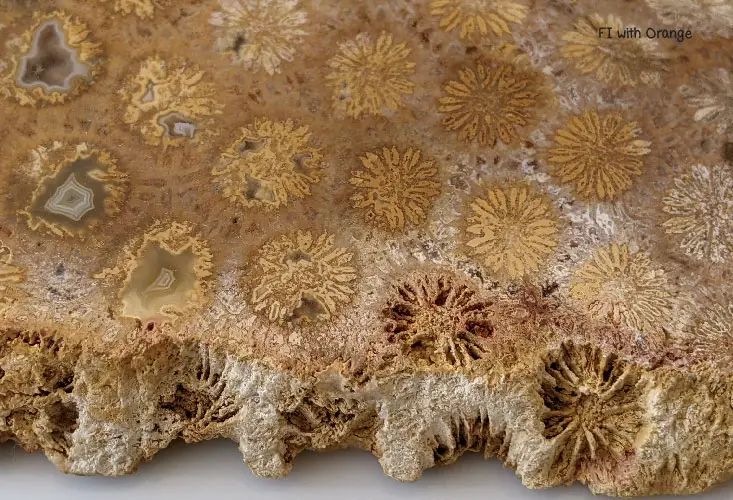
[In this image] The raw stone of agatized fossil coral.
Photo credit: Fi with Orange
Some of them are opaque in nature, but some of them are translucent with different variations.
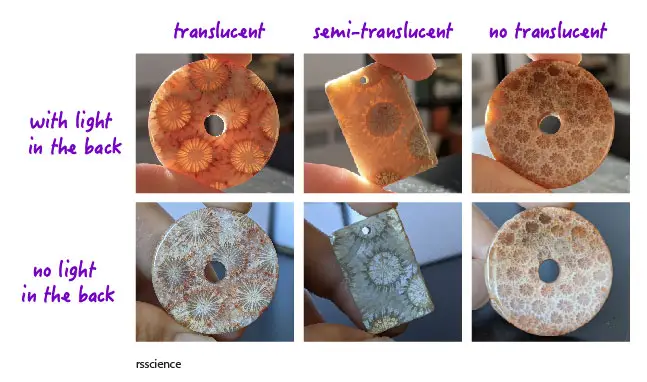
[In this image] Different variations of the translucence of agatized fossil coral.
When you put a flashlight or sunlight in the back of the agatized fossil coral, you can see its translucence, translucent, semi-translucent, or no translucent.
Photo credit: Fi with Orange
Agatized fossil coral under a microscope
I use a digital USB microscope to examine some agatized fossil coral pendants. Please check the article.
Agatized fossil coral jewelry care
Agatized fossil corals are ok to contact water. The best care is to wear it often. The oil/sweat generated by our bodies can moisturize/brighten the agatized fossil coral. Some agatized fossil corals can change their color after wearing them for several weeks. It varies from person to person because each person’s body fluid composition is different.
When you don’t wear it, you can store agatized fossil corals in a Ziplock plastic bag. Agatized fossil corals like humidity. Therefore, you can also spray very little water to keep some moisture in the bag. Don’t soak them in water for days.
Some translucent agatized fossil corals are sensitive to water. Their flower pattern might change or disappear after soaking in water for days.
References
Fossil Coral – Color, Facts, Power, Mythology, History And Myths
Digital Atlas of Ancient Life
Kentucky Geological Survey

